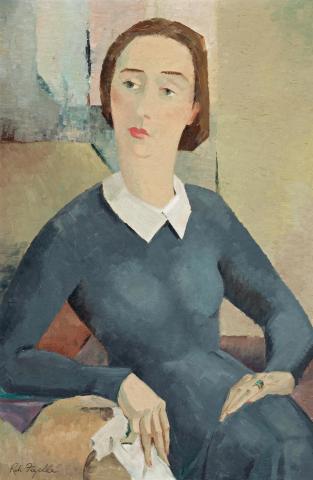SEATED WOMAN, 1932-33
RAH FIZELLE
oil on canvas on board
80.0 x 52.5 cm
signed lower left: Rah Fizelle
inscribed and dated verso: 1932 - 1933/ For little lovable/ Margaret Stewart/ (c/o of Margaret Campbell)/ when she reaches the/ age of 18/ Heather Fizelle
The great niece of the artist, private collection, Sydney
Rah Fizelle was one of the leading figures in pioneering abstract art in Sydney during the thirties and forties. Close friend of Sydney modernists Frank and Margel Hinder, Grace Crowley and Ralph Balson, he was a highly gifted teacher. His election in 1939 as the first president of the Contemporary Art Society bears testament to his other considerable skills; his participation in the 1939 Exhibition I of semi-abstract works being part of our art history. The outstanding portrait, Emily, c.1939, was one of the four works Fizelle included in Exhibition I. It is now in the collection of the Art Gallery of New South Wales.
The previously unknown Seated Woman is a fine example, subtle in its colour scheme and worked in a characteristically balanced semi-figurative style. Today, in the face of the avant-garde extremities of the last fifty years, it is not easy to discern the pioneering achievements of Fizelle and his early Sydney modernists without looking at them in the context of the heavy-handed conservatism of Australian art in the thirties. A comparison of Seated Woman with either of the Archibald Prize winners for 1932 and 1933 - Ernest Buckmaster's The Hon. William Irvine and Charles Wheeler's Ambrose Pratt, Esq - gives a good idea of how advanced he was for his time. Not surprisingly, Fizelle had unsuccessfully entered his portrait of Miss Ellen Grey in the 1932 prize.
Significantly, Fizelle re-established his friendship with Grace Crowley through the 1930 Archibald Prize in which her modernist Portrait of Gwen Ridley, (collection of the Art Gallery of South Australia), had been hung. This led to them sharing a studio in Sydney's George Street and founding the Crowley- Fizelle School, soon becoming a focus of modernism. Crowley also was a very good portrait painter, as seen in such fine works as Portrait Study. 1928, National Gallery of Australia, Canberra, and Portrait of Lucie Beynis. c.1929. in the Art Gallery of New South Wales. The strong influence of Crowley's art on Fizelle shows in Seated Woman, Fizelle's liking for geometric design giving way to a greater sense of form in a more post-cubist manner. While Fizelle maintained his semi-figurative style throughout his life, Crowley moved progressively towards abstraction.
Fizelle's Seated Woman, paintings by Crowley and Ralph Balson's Portrait of Grace Crowley, 1939, (Art Gallery of New South Wales), are salutatory reminders of the quality and importance of portraiture in the hands of creative artists.
DAVID THOMAS
